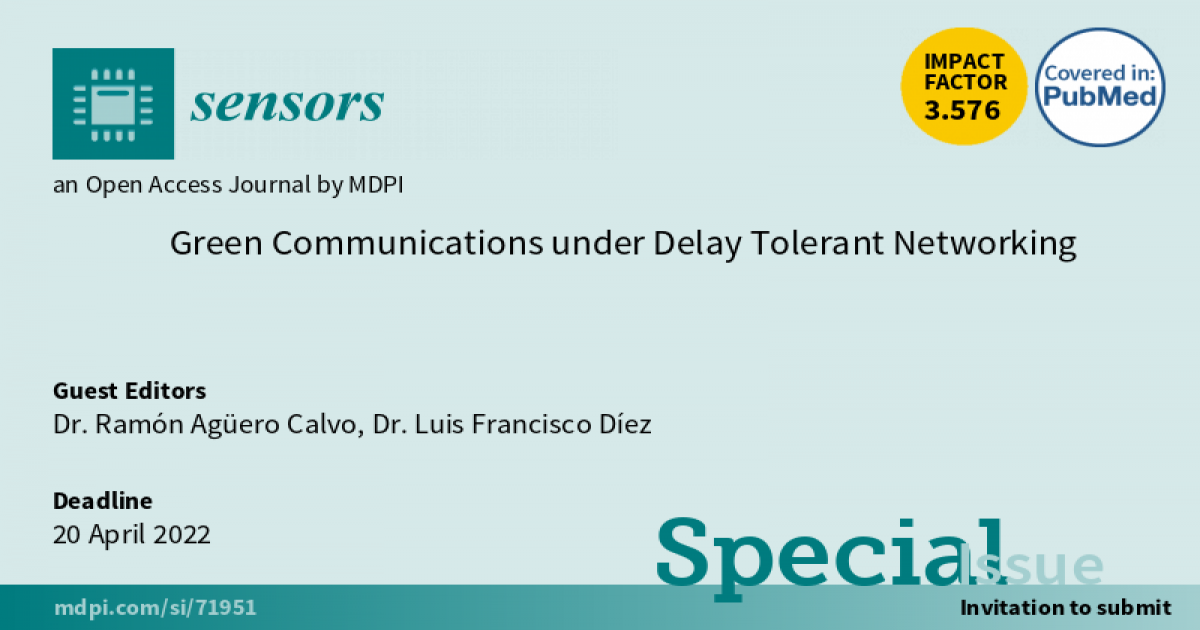- 3.5Impact Factor
- 8.2CiteScore
- 20 daysTime to First Decision
Green Communications under Delay Tolerant Networking
This special issue belongs to the section “Communications“.
Special Issue Information
Dear Colleagues,
In the near future, we expect the appearance of new services with very distinct features, ranging from mMTC to URLLC. In order to fulfill the requirements of such services, we foresee an unprecedented network densification in the forthcoming years, which will require, among other aspects, the convergence of a large number of wireless technologies. On top of that, the adoption of new networking techniques and solutions, particularly those based on virtualization, fosters network adaptability, overcoming traditional Self Organized Network (SON) techniques.
Although energy efficiency has played a key role in the management of communications networks, the research community, and society in general, has remarkably increased the attention paid to this parameter. Among the different services that will emerge in the next years, those that are less demanding (in terms of time requirements), such as Delay-Tolerant Networks (DTNs), will allow for more flexibility and thus energy savings.
This Special Issue aims to gather original studies related to energy efficiency under DTNs, innovative proposals for future networks using novel techniques, solutions for IoT/M2M services, and exploitation of virtualization techniques to develop adaptable networks. Relevant topics of interest include, but are not limited to:
- Application of Low-Power Wide-Area Network (LPWAN) technologies (LoRa, SigFox, etc.) for delay-tolerant IoT/M2M services;
- Energy-aware routing techniques for IoT/M2M scenarios;
- IoT/M2M transport-level (MQTT, SOAP, etc.) solutions for energy reduction in delay-tolerant services;
- Source and network coding for energy-aware DTNs;
- Network Function Virtualization (NFV) and Software Defined Network (SDN) techniques applied to energy minimization;
- Energy-aware solutions for C-RAN/vRAN architectures;
- Energy consumption reduction in Fog/Cloud-based service provisioning
Dr. Ramón Agüero Calvo
Dr. Luis Francisco Díez
Guest Editors
Manuscript Submission Information
Manuscripts should be submitted online at www.mdpi.com by registering and logging in to this website. Once you are registered, click here to go to the submission form. Manuscripts can be submitted until the deadline. All submissions that pass pre-check are peer-reviewed. Accepted papers will be published continuously in the journal (as soon as accepted) and will be listed together on the special issue website. Research articles, review articles as well as short communications are invited. For planned papers, a title and short abstract (about 250 words) can be sent to the Editorial Office for assessment.
Submitted manuscripts should not have been published previously, nor be under consideration for publication elsewhere (except conference proceedings papers). All manuscripts are thoroughly refereed through a single-blind peer-review process. A guide for authors and other relevant information for submission of manuscripts is available on the Instructions for Authors page. Sensors is an international peer-reviewed open access semimonthly journal published by MDPI.
Please visit the Instructions for Authors page before submitting a manuscript. The Article Processing Charge (APC) for publication in this open access journal is 2600 CHF (Swiss Francs). Submitted papers should be well formatted and use good English. Authors may use MDPI's English editing service prior to publication or during author revisions.

Benefits of Publishing in a Special Issue
- Ease of navigation: Grouping papers by topic helps scholars navigate broad scope journals more efficiently.
- Greater discoverability: Special Issues support the reach and impact of scientific research. Articles in Special Issues are more discoverable and cited more frequently.
- Expansion of research network: Special Issues facilitate connections among authors, fostering scientific collaborations.
- External promotion: Articles in Special Issues are often promoted through the journal's social media, increasing their visibility.
- e-Book format: Special Issues with more than 10 articles can be published as dedicated e-books, ensuring wide and rapid dissemination.

